BrazilDry (Brazil)
The BrazilDry experiment is a forest restoration project and a tree biodiversity experiment that looks into the effects of tree diversity and tree facilitation on ecosystem resistance to desertification, carbon sequestration, soil quality and fauna colonization. It was established on a former degraded farmland in the National Forest of Açu Federal Reserve, in the semi-arid Caatinga tropical forest, in July 2016.
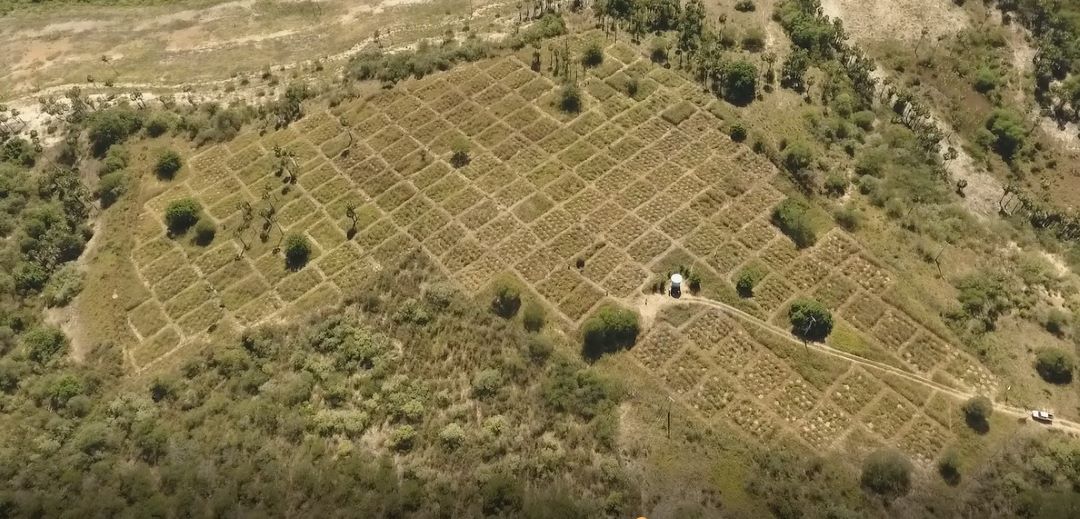
Design
The different community compositions were defined following a random partition design to assign random tree species assemblages to the plots. Tree species richness was 0 (control, no planting), 1 (monocultures), 2, 4, 8, or 16. The communities differed in the level of facilitation, calculated based on the Community Weighted Mean of the facilitation index (RII) for each of the 16 tree species planted. Each community composition was replicated at least 3 times.
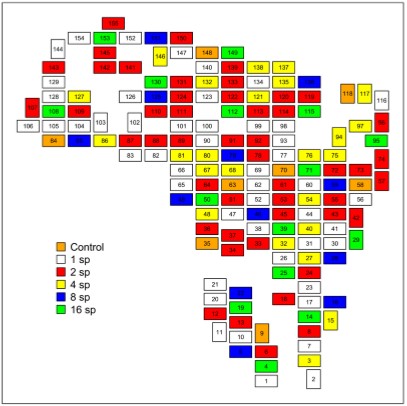
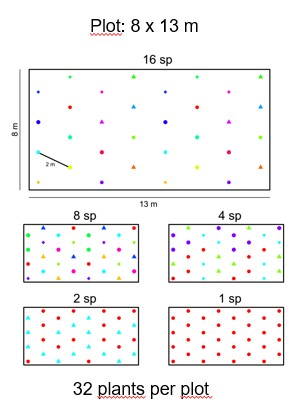
The layout of the 155 plots within the site, and the planting layout of the 32 trees within the plots.
Site characteristics
| BrazilDry (Açu) | |
|---|---|
| Country | Brazil |
| Biome | tropical |
| Latitude | -5.58 |
| Longitude | -36.95 |
| Soil type | Eutrophic Litholic Neosol |
| Former land use | agriculture (10 years abandoned) |
| Altitude | 23 m |
| Design | regular alternate |
| Plot shape | rectangular |
| Plot size (m^2) | 104m² |
| Plant distance (m) | 2 |
| Number of trees planted | 4800 |
| Planting date | July 2016 |
| Diversity variables | species richness |
| Diversity gradient | 0, 1, 2, 4, 8, 16 sp. |
| Size species pool | 16 |
| Species pool | Amburana cearensis Amburana cearensis Anadenanthera colubrine Aspidosperma pyrifolium Bauhinia cheilantha Cochlospermum vitifolium Combretum leprosum Commiphora leptophloeos Cynophalla hastata Handroanthus impetiginosus Libidibia ferrea Mimosa tenuiflora Piptadenia stipulacea Pityrocarpa moniliformis Poincianella gardneriana Pseudobombax marginatum Ziziphus joazeiro |
| Contact person | Gislene Ganade |
| gganade@gmail.com |
Research
The overall goal of the experiment is to develop new restoration techniques to recover degraded dry tropical forests and fight desertification. Hence, the main aim of the experiment is to understand how species diversity and facilitation processes can influence desertification resistance and ecosystem functioning of restored forests. We will quantify desertification (soil exposure), biomass, soil erosion, soil compaction, canopy cover, and fauna colonization.
Extra information
Send an e-mail to the contact person, visit the website of the experiment or explore the publications that utilized data from this experiment.
Research papers
- Blondeel H, Guillemot J, Martin‐StPaul N, Druel A, Bilodeau‐Gauthier S, Bauhus J, … Baeten L 2024 Tree diversity reduces variability in sapling survival under drought. Journal of Ecology 112(5): 1164-1180 - https://doi.org/10.1111/1365-2745.14294
- Dantas A, Dantas TAV, Ganade G, Fonseca CR 2024 Tree richness affects ground-ant diversity and seed dispersal in a tropical biodiversity–ecosystem function experiment. Oikos: e10623 - doi.org/10.1111/oik.10623
- Zheng L, Barry KE, Guerrero-Ramírez NR, Craven D, Reich PB, Verheyen K, … Hautier Y 2024 Effects of plant diversity on productivity strengthen over time due to trait-dependent shifts in species overyielding. Nature communications 15(1): 2078 - https://doi.org/10.1038/s41467-024-46355-z
- Depauw L, De Lombaerde E, Dhiedt E, Blondeel H, Abdala-Roberts L, Auge H, Barsoum N, Bauhus J, Chu C, Damtew A, Eisenhauer N, V. Fagundes M, Ganade G, Gendreau-Berthiaume B, Godbold D, Gravel D, Guillemot J, Hajek P, Hector A, Hérault B, Jactel H, Koricheva J, Kreft H, Liu X, Mereu S, Messier C, Muys B, Nock CA, Paquette A, Parker JD, Parker WC, Paterno, GB, Perring MP, Ponette Q, Potvin C, Reich PB, Rewald B, Scherer-Lorenzen M, Schnabel F, Sousa-Silva R, Weih M, Clara Zemp D, Verheyen K, Baeten L 2024 Enhancing Tree Performance Through Species Mixing: Review of a Quarter-Century of TreeDivNet Experiments Reveals Research Gaps and Practical Insights. Current Forestry Reports - https://doi.org/10.1007/s40725-023-00208-y
- Fagunders MV, Mazzochini GG, Ganade G 2023 The role of plant diversity and facilitation during tropical dry forest restoration. Journal of Ecology 111(6): 1231-1241 - https://doi.org/10.1111/1365-2745.14091
- FAO 2023 Towards more resilient and diverse planted forests. Unasylva (254)74: 2031/1. Rome. https://doi. org/10.4060/cc8584en
- Messier C, Bauhus J, Sousa-Silva R, Auge H, Baeten L, Barsoum N, Bruelheide H, Caldwell B, Cavender-Bares J, Dhiedt E, Eisenhauer N, Ganade G, Gravel D, Guillemot J, Hall JS, Hector A, Hérault B, Jactel H, Koricheva J, Kreft H, Mereu S, Muys B, Nock CA, Paquette A, Parker JD, Perring MP, Ponette Q, Potvin C, Reich PB, Scherer-Lorenzen M, Schnabel F, Verheyen K, Weih M, Wollni M, Zemp DC 2021 For the sake of resilience and multifunctionality, let’s diversify planted forests! Conservation Letters e12829 - https://doi.org/10.1111/conl.12829
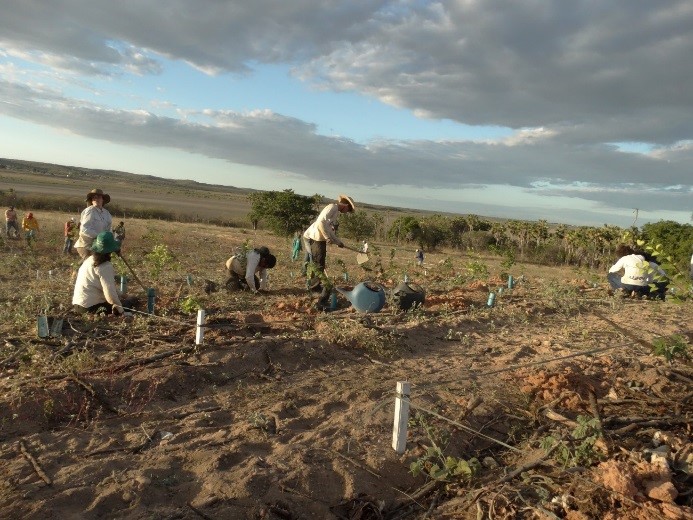
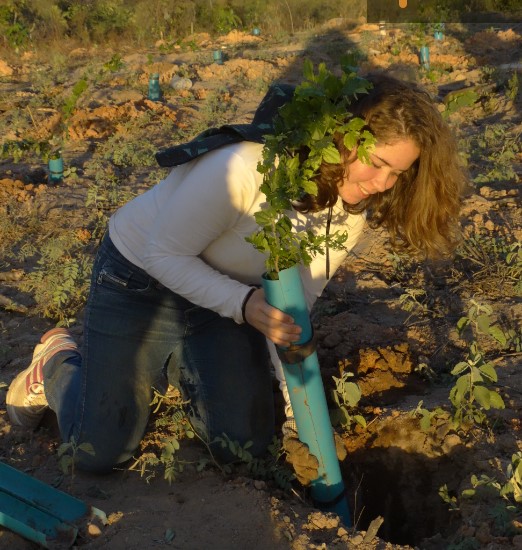
Planting the experiment (Jul 2016)
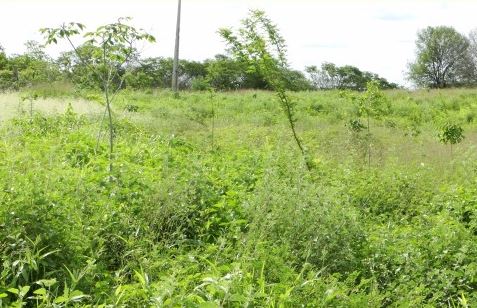
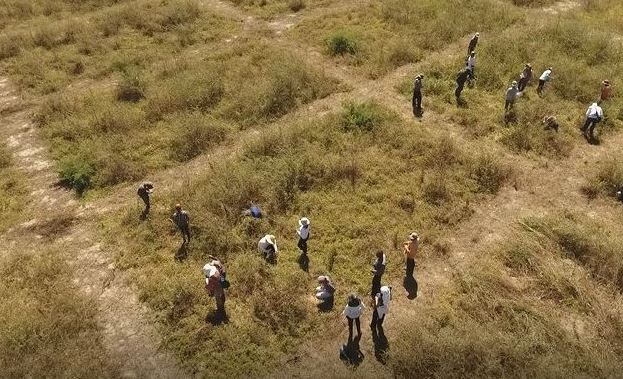
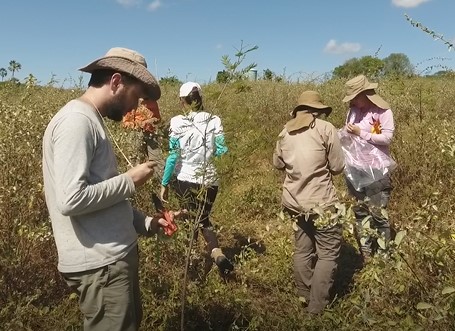
Monitoring the experiment (Jun 2017)